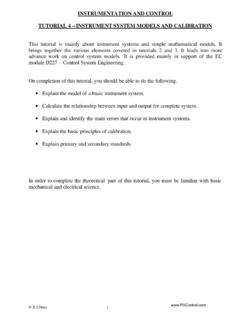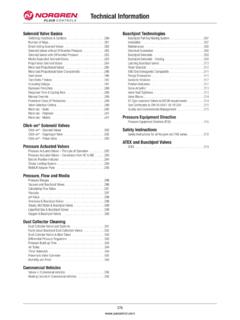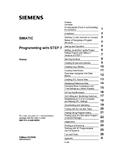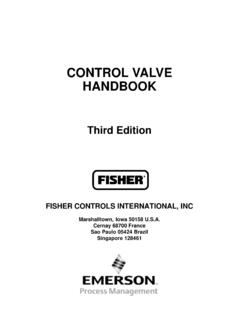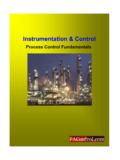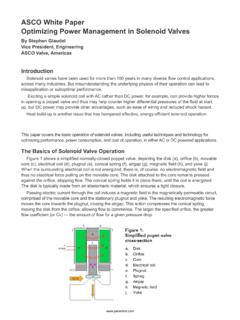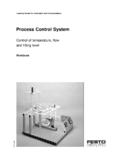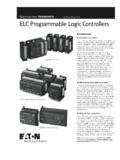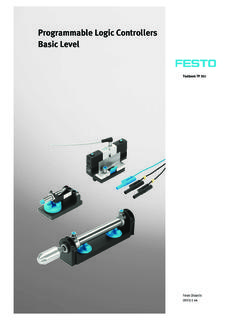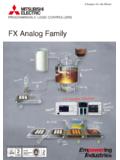Transcription of PROGRAMABLE LOGIC CONTROLLERS - Process …
1 programmable LOGIC CONTROLLERSANDLADDER LOGICS ubmitted to Dr. Alfred R. BoysenDepartment of HumanitiesSouth Dakota School of Mines and TechnologyTechnical Communications IBy Greg P. ZimmermanApril 2008113361 Gideon s TrailKeystone, SD 57751 April 10, 2008Dr. Alfred R. BoysenDepartment of HumanitiesSouth Dakota School of Mines and TechnologyRapid City, South Dakota 57701 Dear Dr. Boysen:I am submitting the following report, programmable LOGIC CONTROLLERS and Ladder LOGIC , for English 279 Technical Communications report discusses: 1) PLC and controls history, 2) PLC components, 3) ladder LOGIC , and 4) ladder LOGIC programming. I would like to take this time to thank you Dr. Boysen, for making this class the first English class I have enjoyed. Your teaching techniques are one of the main reasons in my continued interest in English and the liberal arts.
2 Your flexibility with me and my own techniques has helped me to learn more about myself as well. This is the first paper that I have enjoyed writing in quite a long time, and this is because I was allowed to write it about what I wanted to write about. When I enter the workforce, I will remember what you have taught me so that I may be better able to communicate my ideas to my coworkers, investors, or whoever else it may be. In this report I hope to further the reader s understanding of LOGIC CONTROLLERS and ladder ,Greg P. ZimmermanElectrical Engineering Undergraduate2 TABLE OF CONTENTSList of of Relay to Relay LOGIC AND & OR Timers and a PLC/Ladder LOGIC OF FIGURESF igure 1: Typical Small Scale Control 2: Typical PLC Control 3: PLC Components 4: PLC Scan 5: Basic Ladder LOGIC 6: Electromechanical 7: Basic Relay LOGIC 8: Relay LOGIC Circuit with Jog function 9: Relay LOGIC Circuit with Jog function and Status 10: Complex Ladder 11: Simplified LOGIC 12: Simplified AND 13: Simplified OR 14: On-Delay Timer (RTO).
3 28 Figure 15: Up 16: Ladder Diagram in Relay 17: Relay Diagram with overload 18: Relay Circuit with Addition of Jog 19: Relay Circuit with Addition of Status 20: Relay LOGIC Diagram Converted to PLC Ladder report answers basic questions that may be posed by anyone in the Electrical Engineering field, including electrical engineering technicians and electricians. The reader does not need to have any background in controls or ladder LOGIC ; only an interest in how PLCs work and a basic understanding of digital LOGIC . The questions that will be answered in this report are:1. What is a PLC?2. What is ladder LOGIC ?3. What are the different PLC components?4. How does ladder LOGIC work?5. How does a PLC system work in conjunction with everything else?6. How do you program a ladder LOGIC program?In order to answer all of these questions, I have relied on my personal knowledge of programmable LOGIC CONTROLLERS and ladder LOGIC along with my work experience with report provides the reader with information on: 1) programmable LOGIC history and the advancement of controls technology along with PLC operation, 2) PLC components, 3) ladder LOGIC , and 4) ladder LOGIC LOGIC CONTROLLERS (PLCs) have become the most predominant control elements for the discrete event control of a mechatronics system.
4 Simplification of engineering and precise control of manufacturing Process can result in significant cost savings. The most cost-effective way which can pay big dividends in the long run is flexible automation; a planned approach towards integrated control systems. It requires a conscious effort on the part of plant managers and engineers to identify areas where automation can result in better deployment and/or utilization of human resources and savings in man-hours or down time. Controls automation need not be high ended and extremely sophisticated; it is the phased, step-by-step effort to automate, employing control systems tailored to one s specific requirements that achieves the most attractive results. This is where programmable LOGIC controls have been a breakthrough in the field of automation and control techniques.
5 This report looks at the role PLCs play in these techniques. A constant demand for better and more efficient manufacturing and Process machinery has led to the requirement for higher quality and reliability in control techniques. With the availability of intelligent, compact solid state electronic devices, it has been possible to provide control systems that can reduce maintenance, down time and improve productivity to a great extend. By installing an efficient and user friendly electronics systems for manufacturing machinery or processors, one can obtain a precise and reliable means for producing quality products. One of the latest techniques in solid state controls that offers flexible and efficient operation to the user is programmable The basic idea behind these programmable CONTROLLERS was to provide means to eliminate high cost associated with inflexible, conventional relay controlled systems.
6 programmable CONTROLLERS offer a system with computer flexibility that is suited to withstand the harsh industrial environment, has simplicity of operation/readability, can reduce machine down time and provide expandability for future and is able to be maintained by plant report is an informative overview of the purpose of programmable LOGIC CONTROLLERS and ladder LOGIC . Due to the complexity of programmable LOGIC CONTROLLERS and ladder LOGIC , only the basic operation and programming will be discussed. Prior knowledge of basic electrical circuitry, controls, and computer programming is suggested before reading this order for the reader to better understand this report, the following questions will be explained:1. What is a PLC?2. What is ladder LOGIC ?3. What are the different PLC components?4. How does ladder LOGIC work?
7 5. How does a PLC system work in conjunction with everything else?6. How do you program a ladder LOGIC program? of DevelopmentTo answer these questions, the report will include the following sections:1. programmable LOGIC History: This section will discuss the history and advancement of controls technology, with a comparison of programmable LOGIC CONTROLLERS and hard-wired relays. It will also discuss PLC PLC components: This section will define what programmable LOGIC is and describe all hardware associated with Ladder LOGIC : This section will cover ladder LOGIC and its general progression from relay Ladder LOGIC Programming: This section will cover basic programming techniques and their LOGIC HistoryPLC HistoryPLCs were first introduced in the 1960 s. The primary reason for designing such a device was eliminating the large cost involved in replacing the complicated relay based machine control systems.
8 Bedford Associates (Bedford, MA) proposed something called a Modular Digital controller (MODICON) to a major US car manufacturer. The MODICON 084 brought the world's first PLC into commercial production. When production requirements changed so did the control system. This becomes very expensive when the change is frequent. Since relays are mechanical devices they also have a limited lifetime because of the multitude of moving parts. This also required strict adhesion to maintenance schedules. Troubleshooting was also quite tedious when so many relays are involved. Now picture a machine control panel that included many, possibly hundreds or thousands, of individual relays. The size could be mind boggling not to mention the complicated initial wiring of so many individual devices. These relays would be individually wired together in a manner that would yield the desired outcome.
9 The problems for maintenance and installation were new CONTROLLERS also had to be easily programmed by maintenance and plant engineers. The lifetime had to be long and programming changes easily performed. They also had to survive the harsh industrial environment. The answers were to use a programming technique most people were already familiar with and replace mechanical parts with solid-state ones which have no moving parts. Communications abilities began to appear in approximately 1973. The first such was Modicon's Modbus. The PLC could now talk to other PLCs and they could be far away from the actual machine they were controlling. They could also now be used to send and receive varying voltages to allow them to use analog signals, meaning that they were now applicable to many more control systems in the world.
10 Unfortunately, the lack of standardization coupled with continually changing technology has made PLC communications a nightmare of incompatible protocols and physical networks. The 1980 s saw an attempt to standardize communications with General Motor's manufacturing automation protocol (MAP). It was also a time for reducing the size of the PLC and making them software programmable through symbolic programming on personal computers instead of dedicated programming terminals or handheld 1990 s saw a gradual reduction in the introduction of new protocols, and the modernization of the physical layers of some of the more popular protocols that survived the 1980's. PLCs can now be programmable in function block diagrams, instruction lists, C and structured text all at the same time. PC's are also being used to replace PLCs in some applications.
